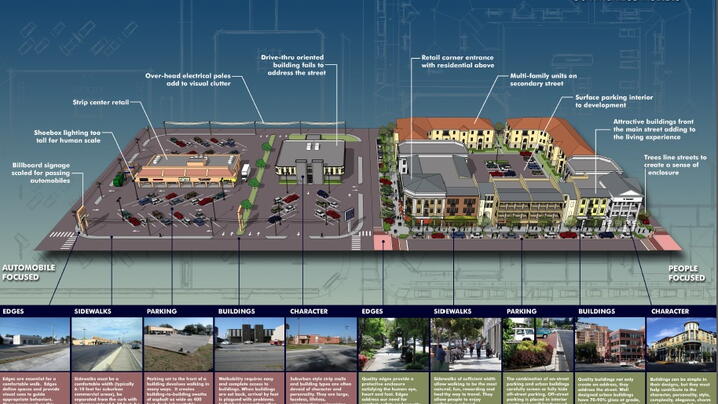
An equation that is false,
Growth = Sustainability
An equation that is true,
Growth does not = Sustainability
Why do I say this?
We have a shared belief in our profession (me included) that growth will take care of the underlying financial imbalances we’ve created in our communities – namely growth will provide us with money to pay for our aging infrastructure. This presumption goes beyond our profession and is prevalent throughout our country. Americans seem to believe, though it's never been shown, that growth will bring us stability and, thus, sustainability.
If you look at this simple poster (to the right) it explains the paradox that we've created.
Which side of this poster will generate the most money over time to maintain the infrastructure underneath it or tied to it? It’s easy to see. It’s the one that’s denser with more uses. The denser development likely provides the most benefit (money) to pay for infrastructure long-term. Why? It has more uses….more potential uses and a large upfront investment that somebody (bank, developer, city) will want to protect. The one on the left is disposable development—with a 10-year life (equal to the commercial loan) that a developer was able to borrow against. If it makes it 10-years the profits have been captured and anything after that is just gravy. 10 years, who cares?
So, my question to the profession is why do we keep building the stuff on the left? Which typcially forces us into more green field development.
The planners write about it all of the time – denser, less auto-centric development creates sustainability. Finance Officers tried to address it by booking newly built assets with GASB 34. But, we all duck the issue of what happens when the value of that original infrastructure investement declines and eventually fails and needs replacing. What if we were forced to book our built assets as a liability at the same time. And, what if we allowed that liability to grow over time. What would our balance sheets look like then? If you think unfunded health insurance and pension costs are scarry, they pale in comparison. State and local governments have large unbooked infrastructure liabilities and we all know this. So who is responsible for correcting it?
Here’s an excellent resource (http://www.strongtowns.org/the-growth-ponzi-scheme/) on what many are terming the “Growth Ponzi Scheme” and it comes from the Strong Towns website (www.strongtowns.org). I think we've all fallen victim to the growth ponzi scheme. So how do we change it?
New, Reduced Membership Dues
A new, reduced dues rate is available for CAOs/ACAOs, along with additional discounts for those in smaller communities, has been implemented. Learn more and be sure to join or renew today!

